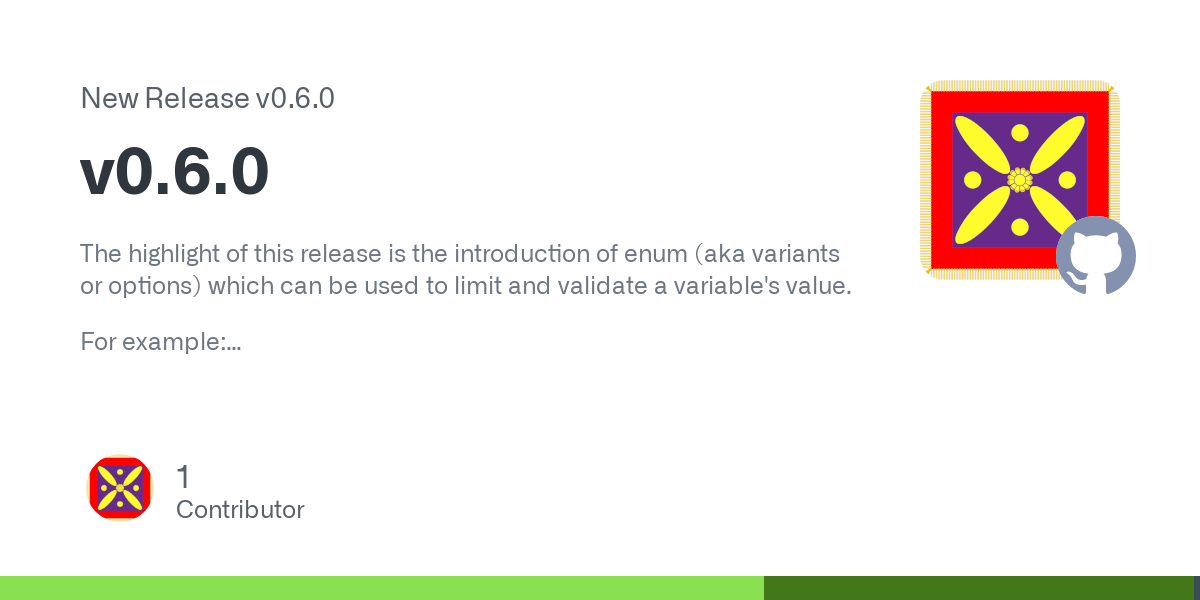bahmanm
Husband, father, kabab lover, history buff, chess fan and software engineer. Believes creating software must resemble art: intuitive creation and joyful discovery.
Views are my own.
- 38 Posts
- 86 Comments
Good question!
IMO a good way to help a FOSS maintainer is to actually use the software (esp pre-release) and report bugs instead of working around them. Besides helping the project quality, I'd find it very heart-warming to receive feedback from users; it means people out there are actually not only using the software but care enough for it to take their time, report bugs and test patches.
 1·1 year ago
1·1 year agoI usually capture all my development-time "automation" in Make and Ansible files. I also use makefiles to provide a consisent set of commands for the CI/CD pipelines to work w/ in case different projects use different build tools. That way CI/CD only needs to know about
make build,make test,make package, … instead of Gradle/Maven/… specific commands.Most of the times, the makefiles are quite simple and don't need much comments. However, there are times that's not the case and hence the need to write a line of comment on particular targets and variables.
 1·1 year ago
1·1 year agoCan you provide what you mean by check the environment, and why you’d need to do that before anything else?
One recent example is a makefile (in a subproject), w/ a dozen of targets to provision machines and run Ansible playbooks. Almost all the targets need at least a few variables to be set. Additionally, I needed any fresh invocation to clean the "build" directory before starting the work.
At first, I tried capturing those variables w/ a bunch of
ifeqs,shells anddefines. However, I wasn't satisfied w/ the results for a couple of reasons:- Subjectively speaking, it didn't turn out as nice and easy-to-read as I wanted it to.
- I had to replicate my (admittedly simple)
cleantarget as a shell command at the top of the file.
Then I tried capturing that in a target using
bmakelib.error-if-blankandbmakelib.default-if-blankas below.############## .PHONY : ensure-variables ensure-variables : bmakelib.error-if-blank( VAR1 VAR2 ) ensure-variables : bmakelib.default-if-blank( VAR3,foo ) ############## .PHONY : ansible.run-playbook1 ansible.run-playbook1 : ensure-variables cleanup-residue | $(ansible.venv) ansible.run-playbook1 : ... ############## .PHONY : ansible.run-playbook2 ansible.run-playbook2 : ensure-variables cleanup-residue | $(ansible.venv) ansible.run-playbook2 : ... ##############But this was not DRY as I had to repeat myself.
That's why I thought there may be a better way of doing this which led me to the manual and then the method I describe in the post.
running specific targets or rules unconditionally can lead to trouble later as your Makefile grows up
That is true! My concern is that when the number of targets which don't need that initialisation grows I may have to rethink my approach.
I'll keep this thread posted of how this pans out as the makefile scales.
Even though I’ve been writing GNU Makefiles for decades, I still am learning new stuff constantly, so if someone has better, different ways, I’m certainly up for studying them.
Love the attitude! I'm on the same boat. I could have just kept doing what I already knew but I thought a bit of manual reading is going to be well worth it.
 1·1 year ago
1·1 year agoThat's a great starting point - and a good read anyways!
Thanks 🙏
 1·1 year ago
1·1 year agoAgree w/ you re trust.
 1·1 year ago
1·1 year agoThanks. At least I've got a few clues to look for when auditing such code.
I didn't like the capitalised names so configured xdg to use all lowercase letters. That's why
~/optfits in pretty nicely.You've got a point re
~/.local/optbut I personally like the idea of having the important bits right in my home dir. Here's my layout (which I'm quite used to now after all these years):$ ls ~ bin desktop doc downloads mnt music opt pictures public src templates tmp videos workspacewhere
binis just a bunch of symlinks to frequently used apps fromoptsrcis where i keep clones of repos (but I don't do work insrc)workspaceis a where I do my work on git worktrees (based offsrc)
Thanks! So much for my reading skills/attention span 😂
Which Debian version is it based on?

 133·1 year ago
133·1 year agoSomething that I'll definitely keep an eye on. Thanks for sharing!
RE Go: Others have already mentioned the right way, thought I'd personally prefer
~/opt/goover what was suggested.
RE Perl: To instruct Perl to install to another directory, for example to
~/opt/perl5, put the following lines somewhere in your bash init files.export PERL5LIB="$HOME/opt/perl5/lib/perl5${PERL5LIB:+:${PERL5LIB}}" export PERL_LOCAL_LIB_ROOT="$HOME/opt/perl5${PERL_LOCAL_LIB_ROOT:+:${PERL_LOCAL_LIB_ROOT}}" export PERL_MB_OPT="--install_base \"$HOME/opt/perl5\"" export PERL_MM_OPT="INSTALL_BASE=$HOME/opt/perl5" export PATH="$HOME/opt/perl5/bin${PATH:+:${PATH}}"Though you need to re-install the Perl packages you had previously installed.

 3·1 year ago
3·1 year agoFirst off, I was ready to close the tab at the slightest suggestion of using Velocity as a metric. That didn't happen 🙂
I like the idea that metrics should be contained and sustainable. Though I don't agree w/ the suggested metrics.
In general, it seems they are all designed around the process and not the product. In particular, there's no mention of the "value unlocked" in each sprint: it's an important one for an Agile team as it holds Product accountable to understanding of what is the $$$ value of the team's effort.
The suggested set, to my mind, is formed around the idea of a feature factory line and its efficiency (assuming it is measurable.) It leaves out the "meaning" of what the team achieve w/ that efficiency.
My 2 cents.
Good read nonetheless 👍 Got me thinking about this intriguing topic after a few years.

 4·1 year ago
4·1 year agoThis is fantastic! 👏
I use Perl one-liners for record and text processing a lot and this will be definitely something I will keep coming back to - I've already learned a trick from "Context Matching" (9) 🙂
 2·1 year ago
2·1 year agoI couldn't agree more 😂
Except that, what the author uses is pretty much standard in the Go ecosystem, which is, yes, a shame.
To my knowledge, the only framework which does it quite seamlessly is Spring Boot which, w/ sane and well thought out defaults, gets the tracing done w/o the programmer writing a single line of code to do tracing-related tasks.
That said, even Spring's solution is pretty heavy-weight compared to what comes OOTB w/ BEAM.
 1·1 year ago
1·1 year agoI got to admit that your point about the presentation skills of the author are all correct! Perhaps the reason that I was able to relate to the material and ignore those flaws was that it's a topic that I've been actively struggling w/ in the past few years 😅
That said, I'm still happy that this wasn't a YouTube video or we'd be having this conversation in the comments section (if ever!) 😂
To your point and @krnpnk@feddit.de's RE embedded systems:
That's absolutely true that such a mindset is probably not going to work in an embedded environment. The author, w/o explicitly mentioning it anywhere, is explicitly talking about distributed systems where you've got plenty of resources, stable network connectivity and a log/trace ingestion solution (like Sumo or Datadog) alongside your setup.
That's indeed an expensive setup, esp for embedded software.
The narrow scope and the stylistic problem aside, I believe the author's view is correct, if a bit radical.
One of major pain points of troubleshooting distributed systems is sifting through the logs produced by different services and teams w/ different takes of what are the important bits of information in a log message.It get extremely hairy when you've got a non-linear lifeline for a request (ie branches of execution.) And even worse when you need to keep your logs free of any type of information which could potentially identify a customer.
The article and the conversation here got me thinking that may be a combo of tracing and structured logging can help simplify investigations.
 2·1 year ago
2·1 year agoThanks for sharing your insights.
Thinking out loud here…
In my experience with traditional logging and distributed systems, timestamps and request IDs do store the information required to partially reconstruct a timeline:
- In the case of a linear (single branch) timeline you can always "query" by a request ID and order by the timestamps and that's pretty much what tracing will do too.
- Things, however, get complicated when you've a timeline w/ multiple branches.
For example, consider the following relatively simple diagram.
Reconstructing the causality and join/fork relations between the executions nodes is almost impossible using traditional logs whereas a tracing solution will turn this into a nice visual w/ all the spans and sub-spans.

That said, logs do shine when things go wrong; when you start your investigation by using a stacktrace in the logs as a clue. That (stacktrace) is something that I'm not sure a tracing solution will be able to provide.
they should complement each other
Yes! You nailed it 💯
Logs are indispensable for troubleshooting (and potentially nothing else) while tracers are great for, well, tracing the data/request throughout the system and analyse the mutations.
 1·1 year ago
1·1 year agoI'm not sure how this got cross-posted! I most certainly didn't do it 🤷♂️

 231·1 year ago
231·1 year agoThis is quite intriguing. But DHH has left so many details out (at least in that post) as pointed out by @breadsmasher@lemmy.world - it makes it difficult to relate to.
On the other hand, like DHH said, one's mileage may vary: it's, in many ways, a case-by-case analysis that companies should do.
I know many businesses shrink the OPs team and hire less experienced OPs people to save $$$. But just to forward those saved $$$ to cloud providers. I can only assume DDH's team is comprised of a bunch of experienced well-payed OPs people who can pull such feats off.
Nonetheless, looking forward to, hopefully, a follow up post that lays out some more details. Pray share if you come across it 🙏
 0·1 year ago
0·1 year agoUh, I’m not sure I understand what you mean.








Thanks for the pointer! Very interesting. I actually may end up doing a prototype and see how far I can get.